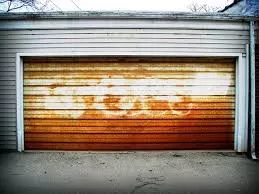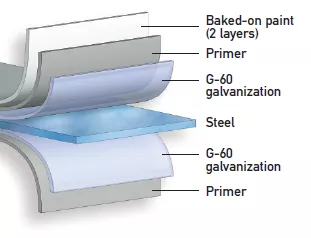Your garage door is one of the most significant parts of your home’s exterior aesthetic. It’s also a financial investment and you want it to stand the test of time. It can be disheartening to find that your garage door has rust spots on it, even though it’s only a few years old. Why didn’t the paint protect it? Why is it rusting in the first place?
First, you need to take a long, hard look at the environment in which your door is installed and determine if there are any factors that might make rust more likely. When you’ve taken those initial steps, you’ll find that it’s easier to prevent problems down the road. However, understand that washing your garage door is an important first step in protecting it. Below, we’ll explore some of the other things that you need to know.

Check the surroundings
Before you do anything else, consider the environment in which the garage door is installed. Do you live near the coast? If so, salt in the air can cause the garage door to suffer premature wear and tear. Do you live in a desert area? If so, prolonged exposure to harsh sunlight can compromise the protection offered by even the highest-quality paint. Do you live in an area where there’s lots of snowfall during the winter? Salt used to de-ice your roads could be causing problems with your garage door.
These are just a few of the situations that garage door specialists encounter on a regular basis. Actually, it might not even be rust that you’re seeing. If you have white and yellow birch trees in the area, you may see rust-like stains in the spring and fall. This is just pollen and can be washed away easily.
Garage door paint: consider the type
If your garage door has started to show signs of rust, it could be a problem with the paint. In most cases, garage door manufacturers serving customers in North America apply a primer coat of paint, and then another coat of paint that is baked on. There is even rust-protection built into the very metal of the garage door.
Most companies use a steel/zinc mixture that is resistant to rust formation. It’s actually very common – the Association of North American Garage Door Manufacturers (DASMA) has detailed guidelines that members must follow to ensure protection and rust resistance.

Was the garage door you own previously repainted? If the door is older, and it has been repainted, there is chance that it was not done correctly, or the job was not handled by a professional with experience dealing with garage doors. In this situation, you need to find out what steps were followed prior to painting, as well as what type of paint was used on the door.
Finally, understand that no amount of paint or galvanization will help if the surface is damaged. Scrapes can remove the protection offered by paint. Punctures allow rust to begin forming in other areas of the door. Any type of physical damage could compromise your protection.
Clean the door thoroughly
A clean garage door is a protected garage door. Many people never think about washing their doors, but it is an important part of basic maintenance. If you’re pressed for time, consider doing it when you wash your car – it adds just a few minutes, and you’ll already have the tools that you need for the job. Washing your door will remove dust, dirt, pollen, and other buildup, and help make sure your door looks its best. If you notice any oil stains, chances are good they are from over lubricating the drive chain with oil rather than white grease.
You do need to make sure that you wash your garage door properly. To do this, you’ll need a mild soap, such as what you use to wash your car. Liquid dish soap will also work in a pinch. Use a sponge or soft cloth, wash down the garage door, and then rinse it. Under no circumstances should you use a pressure washer on your garage door. Fragile paint can be damaged very easily by the high-pressure water. Use a garden hose with a medium setting on the nozzle.
What to do with rust spots
If you do notice rust spots, chances are good that they will be small dots that look like debris, but they will not wipe away. Rust is most likely to form on the bottom two panels of the garage door, which are located closer to the street and any sort of abrasive elements.
There are two types of rust stains. Surface stains can actually be removed with a mild mixture of water and vinegar in equal proportions. Apply it with a squirt bottle, then use a clean cloth to wipe away the rust. If you cannot get the area clean, use a mild abrasive cleaner.
You can make your own with baking soda and water. Combine the two until a paste forms, then apply the paste to the rust spots. Let it sit for about 30 minutes, then clean it away. Tile cleaner may also be able to help you get rid of surface rust. The second type of rust is deeper down and cannot be cleaned – the door itself will need to be replaced.
The frequency of washing
Like other parts of your home, your garage door will require washing regularly. We recommend that you do it twice per year – once in the spring and then again in the fall. However, if you live an in area where air pollution is high, you may need to wash it more often. You can also follow the simple directions here in Garaga’s maintenance guide. It’s a bit more intensive, but it can pay off quite well.
Need a new door?
If you think that a new garage door is in order, and you live near Midland, get in touch with us to learn more about your garage door options. Call us at 705-322-0136.








Add new comment